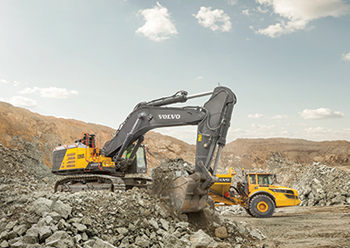What to consider when buying a new machine
Volvo Construction Equipment (Volvo CE) outlines some of the questions buyers should have the answers to before considering purchase of a new excavator.
01 March 2020
|
I |
n an attempt to maximise productivity on site, it could be tempting to opt for the biggest machine with the biggest bucket possible – but there’s much more to the purchasing decision for an excavator than that, says Volvo CE.
According to the leading construction equipment manufacturer, four essential questions potential buyers should ask themselves when choosing the size of their new excavator are:
• What kind of material will I be digging?
The biggest bucket is not necessarily going to move the most material in the least amount of time if the material is dense and heavy. To try to fill a large bucket with heavy material that weighs more than the lifting capacity of the machine would be dangerous to the operator and others on the site – and damaging to the machine. Heavy rock will always require a smaller bucket than soft soil for stability, safety and efficiency.
• How will I transport it?
While it is important to match the size of the excavator to the demands of the job, it’s also important to consider how mobile you need the machine to be. What size trucks and trailers does your company have and are there any local hauling restrictions? If you’re investing in a large excavator to operate in a quarry, you’re unlikely to need to move it much at all. In this case, going without a removable counterweight could save on your purchase price (although it would affect the resale value). If you’re working in a city in narrow streets or across highways, you may need to downsize for the tighter spaces or consider a short-swing-radius wheeled excavator.
• What’s my reach requirement?
Some contractors may prefer a shorter arm to increase breakout forces and bucket sizes but operators can feel uncomfortable being so close to a truck when dumping. Likewise, while a shorter arm can increase bucket capacity, operators may not be able to reach the required digging depth. It’s important to consider these issues beforehand as it costs time and money to adjust the arm.
• What track width do I need for stability?
If you are working in a quarry where the material is hard and there are lots of big rocks, narrow tracks are preferable because the wider the pad, the easier it is to bend. If you are working in soft sand, however, you’ll need the widest pad possible to stop the excavator from sinking.
When choosing a new excavator, it’s important to think about all these scenarios as well as weight and horsepower – and get your operators involved. That way you’ll be sure to have a machine that’s right for the job and that your personnel feel comfortable operating – without you having to go back and make unexpected and potentially costly modifications.
- Top tips for buying at auctions
- Hitachi to equip excavators with ConSite solution
- What to consider when buying a new machine
- Bobcat control system wins Samoter award



